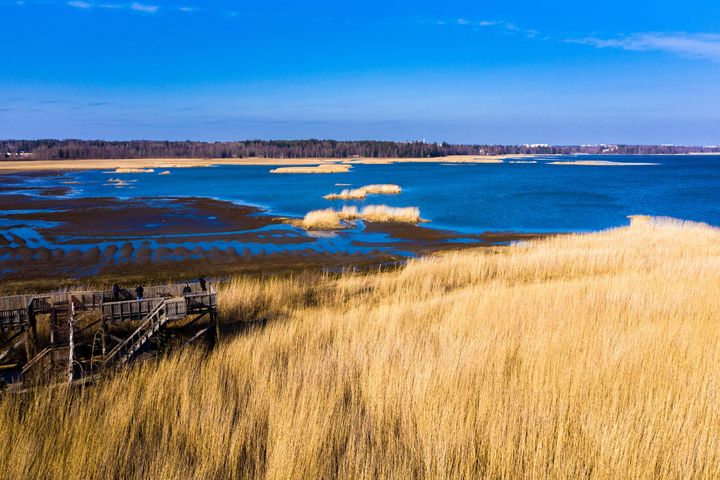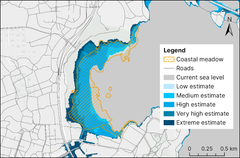Rising sea could erase a significant portion of coastal habitats in Finland
New study estimates that more than a fifth of coastal meadows and sandy beaches may disappear by the turn of the century.

Researchers at Aalto University and the Finnish Environment Institute have for the first time investigated how a rising sea level might impact coastal habitats in Finland. The results are a cause for concern: in the scenario considered most likely to occur, 22–23 percent of coastal meadows and sandy beaches would disappear beneath the waves by the year 2100. Failure to reach emissions reduction targets could cause the sea level to rise more rapidly, causing even greater habitat loss.
‘Coastal habitats are crucial for biodiversity. Their destruction would be an irreplaceable loss to the nearly 700 species that inhabit sandy beaches and coastal meadows,’ says Senior Researcher Terhi Ryttäri from the Finnish Environment Institute.
The new study focuses on the Gulf of Finland coastline, as it is where land uplift is the weakest and thus where sea levels will rise sooner. In the north, land uplift along the coast of the Gulf of Bothnia will slow the impact of sea level rise, yet the area remains susceptible to its effects.
Coastal meadows and sandy beaches do not shift easily
The researchers also investigated whether coastal habitats could shift to areas further inland as the sea rises. They found that this kind of movement is hindered by, among others, the built environment, steep hills, and unsuitable soil.
‘Buildings, roads, and other infrastructure often block habitats from expanding to new areas. Even if there is space for them in theory, not all areas can transform into sandy beaches or coastal meadows,’ says Elisa Kropsu, a geospatial specialist who has completed a master’s thesis on the subject at Aalto University.
The research revealed that, in terms of land area, the space for potential expansion outstrips the coastal meadows that will be lost to sea level rise – in theory. In practice, most of this land is being used for agriculture, and transformation into coastal meadows is not always possible. The expansion of sandy beaches is more limited due to a lack of suitable soil.
Habitats require protection, restoration, and long-term planning
The researchers stress that immediate action is required to protect the coastal environment.
‘Possible measures include the expansion of protected areas, improving the natural state of existing areas, and reserving and preparing suitable expansion areas for coastal habitats,’ says Maaria Nordman, assistant professor of geoinformatics at Aalto University.
The study was published recently in the Boreal Environment Research journal.
Keywords
Contacts
Elisa Kropsu
Geospatial Specialist
elisa.kropsu@ely-keskus.fi
p. 050 351 2967
Terhi Ryttäri
Senior Researcher, Finnish Environment Institute
firstname.surname@syke.fi
p. 0295 251 585
Media service at Finnish Environment Institute
Our Media Service provides information on research, helps journalists find experts for interviews and provides photos for media use.
Our Communication experts will answer your inquiries on weekdays from 9 am to 4 pm.
Images

Finnish Environment Institute - We build hope through research.
Finnish Environment Institute
Latokartanonkaari 11
00790 Helsinki
+358 295 251 000
It is time to move beyond solving environmental problems one by one, to systemic sustainability transformations. The Finnish Environment Institute (Syke) contributes to building a sustainable society through research, information and services. The Finnish Environment Institute is a research institute with 700 experts and researchers located in Helsinki, Oulu, Jyväskylä and Joensuu.

Subscribe to releases from Suomen ympäristökeskus
Subscribe to all the latest releases from Suomen ympäristökeskus by registering your e-mail address below. You can unsubscribe at any time.
Latest releases from Suomen ympäristökeskus
Luontotyyppien ja lajien tilan heikkeneminen jatkuu – Suunta voidaan kääntää investoimalla ennallistamiseen12.9.2025 06:00:00 EEST | Tiedote
Suomi raportoi Euroopan komissiolle luonto- ja lintudirektiivien toimeenpanosta. Arvioinnin tulokset (ym.fi) osoittavat lajien ja luontotyyppien heikkenevän kehityksen jatkuvan edelleen. Myös ennallistamisasetuksen toimeenpanoon tarvitaan yhä enemmän panostuksia lajien ja luontotyyppien tilan parantamiseen sekä seurantaan.
Det varma vädret förde med sig blågröna alger till stränderna igen11.9.2025 18:35:00 EEST | Pressmeddelande
I början av september har det funnits ovanligt många blågröna alger i förhållande till tidpunkten. Den här veckan nådde antalet officiella observationer av blågrönalger rekordnivåer under hela sommaren, både på insjöarna och vid kusten.
Syyskuun lämmin sää toi taas sinilevät rannoille11.9.2025 17:31:02 EEST | Tiedote
Sinilevää on ollut syyskuun alussa ajankohtaan nähden poikkeuksellisen paljon. Tällä viikolla sinilevästä tehtyjen virallisten havaintojen määrä kohosi koko kesän ennätyslukemiin sekä sisävesillä että rannikolla.
Viikkokatsaus 15.–19.9.202511.9.2025 12:06:19 EEST | Tiedote
Hei! Tässä tiedoksesi meillä Suomen ympäristökeskuksessa ensi viikolla ilmestyviä tiedotteita, uutisia, kampanjoita, blogeja ja uutiskirjeitä. Mukana myös tulevia tapahtumia ja webinaareja. Jakelemme viikkokatsauksen torstaisin STT:n kautta. Koosteet löytyvät myös STT-uutishuoneesta, josta voit tilata kaikki Suomen ympäristökeskuksen tiedotteet.
Growth in Finland's cormorant population levelled off11.9.2025 09:00:00 EEST | Press release
In the summer of 2025, approximately 31,910 cormorant nests were counted in Finland. The breeding population decreased by one percent from the previous summer, approximately 280 nests. The change from last year is significant, as in the summer of 2024 the population growth was 15 percent, with 32,190 nests.
In our pressroom you can read all our latest releases, find our press contacts, images, documents and other relevant information about us.
Visit our pressroom